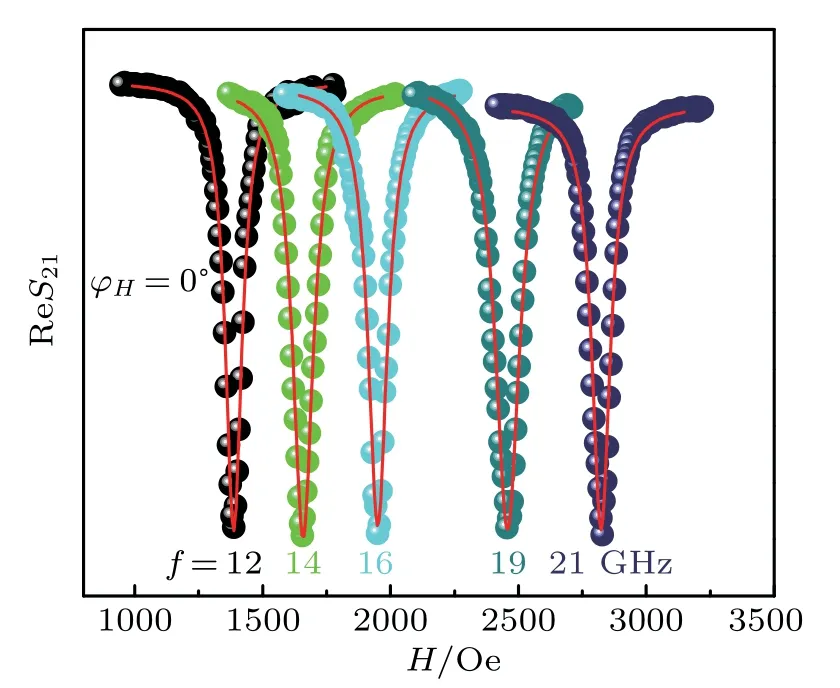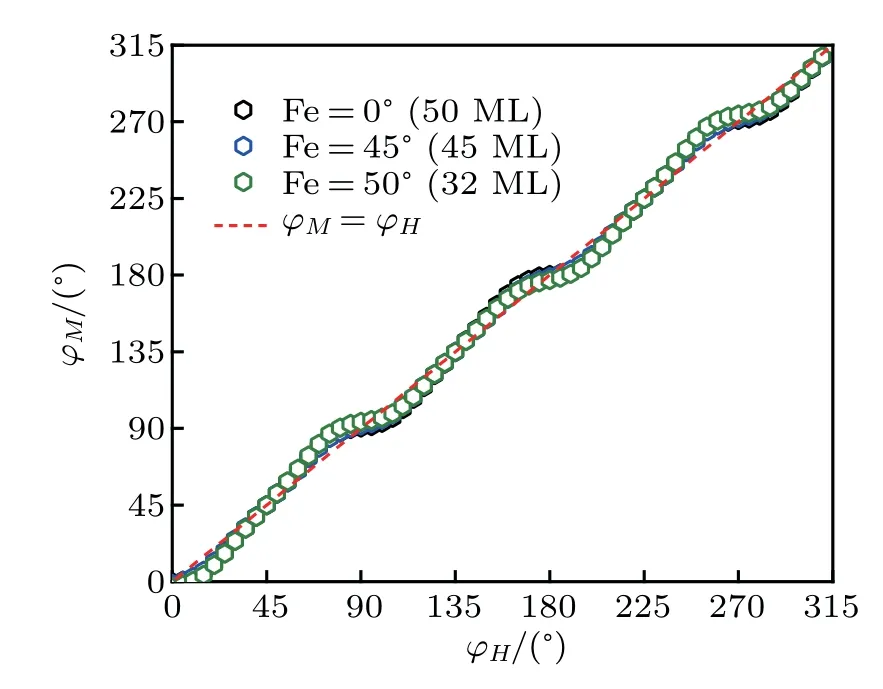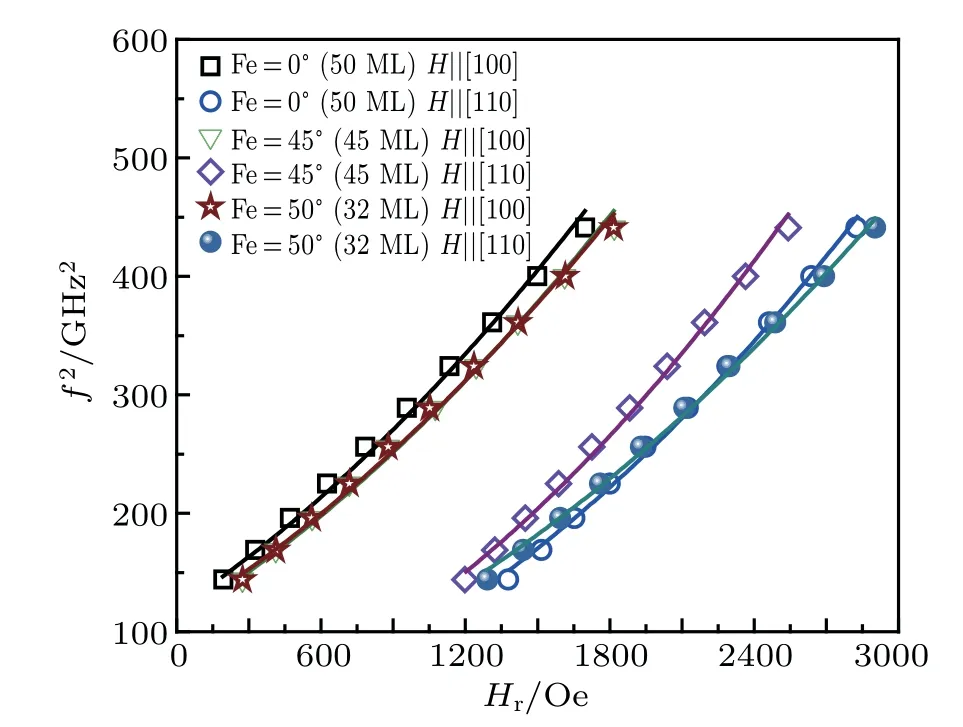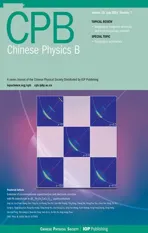Thickness-dependent magnetic anisotropy in obliquely deposited Fe(001)/Pd thin film bilayers probed by VNA-FMR∗
2019-08-06QeematGulWeiHe何为YanLi李岩RuiSun孙瑞NaLi李娜
Qeemat Gul, Wei He(何为), Yan Li(李岩), Rui Sun(孙瑞), Na Li(李娜),
Xu Yang(杨旭)1,2, Yang Li(李阳)1,2, Zi-Zhao Gong(弓子召)1,2, Zong-Kai Xie(谢宗凯)1,2,Xiang-Qun Zhang(张向群)1, and Zhao-Hua Cheng(成昭华)1,2,3,†
1State Key Laboratory of Magnetism and Beijing National Laboratory for Condensed Matter Physics,Institute of Physics,Chinese Academy of Sciences,Beijing 100190,China
2School of Physical Sciences,University of Chinese Academy of Sciences,Beijing 100049,China
3Songshan Lake Materials Laboratory,Dongguan 523808,China
Keywords: oblique angle deposition,iron film thickness,magnetic anisotropy,ferromagnetic resonance
1. Introduction
Ferromagnetic thin films can exhibit extensively modified magnetic properties from their bulk counterparts,[1]including magnetic anisotropy, magnetic homogeneity, and intrinsic magnetic damping properties,[2]thus they have potential applications in microscale actuators and sensors,magnetic recording media components,[3]current-induced magnetization switching devices,[4]and high-density magnetic random access memory.[5]It is not easy to use conventional tools to determine the magnetic anisotropy that controls the operation of these films. The ferromagnetic resonance(FMR)technique is a very sensitive tool for studying the magnetic anisotropy,spin dynamics,and homogeneity of ferromagnetic thin films.
Magnetic anisotropy is one of the basic properties of ferromagnetic materials. In general, there are several ways to enhance in-plane uniaxial magnetic anisotropy (UMA) in ferromagnetic films, such as oblique deposition,[6-8]magnetic annealing,[9-13]and exchange bias.[14-18]Among these,oblique deposition is easy to handle and thus is widely used in practice to increase the ferromagnetic resonance frequency of ferromagnetic thin films.[19,20]Due to the self-shadowing effect,the oblique deposition of ferromagnetic thin films on flat rigid substrates can result in elongated grains perpendicular to the direction of the incident atomic flux. Therefore,during the growth of the ferromagnetic film,UMA with an easy axis perpendicular to the direction of the incident flux is induced.[21]
For decades, FMR has been one of the most effective techniques to determine the crystallinity of ferromagnetic materials and to measure the phenomenological magnetic anisotropy constants. With the increasing interest in research on ferromagnetic thin films, FMR has been used more and more in research into single crystal ferromagnetic thin films.[22-27]The FMR technique has also proven to be a powerful technique for measuring the magnetic properties of oblique anisotropic films.[2]At gigahertz(GHz), FMR accurately measures the static characteristics of large magnetic field saturated magnetic films.[28-30]In these experiments,magnetic resonance was detected by scanning an applied magnetic field. The resonant magnetic field provides a measure of the effective field excited by a uniform magnetic field in a uniform precession mode. The effective field includes contributions from external magnetic fields,demagnetizing fields,and magnetocrystalline energy. The standard FMR technique provides very high sensitivity because the high-quality coefficient of the cavity at the operating frequency is determined by the geometry of the cavity. It is proved that this method can accurately measure the static characteristics of a ferromagnetic film, which are given by the magnetic anisotropy constant.The dynamic characteristics are usually determined by the resonance linewidth ΔH, which provides information about the relaxation process. At present, the magnetic anisotropy behavior of the relaxation mechanism, such as the two-magnon processes at the GHz frequency, is studied using the FMR technique.[31,32]
In this paper,we focus on the static properties of epitaxial Fe(001)/Pd thin film bilayers, which are highly attractive due to the increased switching speed of the magnetic cells in magnetic random access memory(M-RAM)devices.[32,33]In previous studies on similar Fe/MgO(001)thin films with fourfold magnetocrystalline anisotropy (MCA) and a UMA superimposed, the latter is very likely to be along an easy direction, that is, β = 0°or 90°. It is reported that at small Fe thickness, the uniaxial component dominates, and as the thickness increases,the relative anisotropy of cubic anisotropy increases. Therefore, controlling uniaxial anisotropy is important because it facilitates device applications such as magnetic tunnel junctions and spin torque oscillators.[34]In this work, we present results of thickness-dependent magnetic anisotropy of obliquely deposited Fe(001)/Pd thin films on Mg(001) via field-dependent resonant field measurements.Our experimental results are compared with the previous ones obtained from the quasistatic transverse biased inverse susceptibility (TBIS) measurements,[28,35]and high-frequency FMR measurements,[28]as well as the magneto-optical Kerr effect (MOKE) and anisotropic magnetoresistance (AMR)systems,[36]which indicates that in addition to the fourfold MCA due to the body-center cubic (bcc) structure of Fe, an additional UMA is found in the[100]easy direction.
2. Experiment
Using ultra-high vacuum (UHV) molecular beam epitaxy, thin magnetic films of Fe(001)/Pd bilayers were prepared on cleaned MgO(001) substrates via oblique deposition at a base pressure of 2.0×10-10mbar. The substrates were put into a special template-holder and were heated up to 700°C for 2 h. Our previous study showed that this temperature range is the best choice for producing high quality samples. Detailed information on sample preparation and characterization has been provided elsewhere.[36]In this paper,three samples of Fe film thicknesses 50 monolayer(ML),45 ML,and 32 ML,which were 0°normally,and 45°,and 55°obliquely deposited, respectively, were adopted for the study.The magnetic anisotropy was analyzed using an in-plane vector network analyzer ferromagnetic resonance (VNA-FMR)technique. The measurements were performed by placing the samples with film side facing the coplanar waveguide(CPW)at room temperature. A gaussmeter was used to measure the magnetic field at each field. Microwave excitations were generated by connecting one end of the CPW to the output port of the vector network analyzer(VNA).The input port of the VNA was connected to the other end of the CPW,and the complex transmission parameter S21through the CPW was measured at a fixed frequency as the external magnetic field was swept.[37]The field-dependent resonant field measurements were performed by rotating the sample in-plane while sweeping the applied magnetic field.
3. Results and analysis
Figure 1(a) schematically illustrates the sample stacking and measurement configuration. FMR field Hrvalues are obtained by fitting each spectrum to a Lorentzian profile. The FMR spectra (fitted red lines) of the 0°-Fe(50 ML)/Pd sample at φH=0°in the frequency range 12-21 GHz showing the real part of the transmission parameter (ReS21) are illustrated in Fig. 2. For the samples, the magnetic field H was applied along the sample plane. In order to avoid small misalignment between the applied magnetic field and the magnetic anisotropy (the hard axis may cause a large change in resonance response),we used a fixed magnetic field H to measure, but changed the direction of the applied magnetic field φH. In this method,small misalignment is no longer a source of error, as it is now a fitting parameter. In addition, the field-dependent resonant field Hrprovides a simple illustration of the magnetic anisotropy symmetry and the values of the magnetic anisotropy constants that can be extracted from the field-dependent resonant field measurements. The magnetic anisotropy constants are extracted by fitting the resonance field Hrvalues to the following Kittel equation derived from the Landau Lifshitz equation:[38]

Here f =ω/2π is the microwave frequency,γ =gµB/¯h is the gyromagnetic ratio, and Hdis the demagnetization field. In addition,we have

where Msis the saturation magnetization,µ0is the permeability of free space, and Koutis the out-of-plane uniaxial magnetic anisotropy constant. The surface/interface term is very important for ultrathin films (a few monolayers), but it becomes negligible for films exceeding several tens of monolayers. For the thickness dependence, Hdshould satisfy the condition Hd=Msas thickness t →∞.[39]Also, the samples are single crystals, and no significant Koutis present in the samples so can,therefore,be neglected in the analysis.

Fig.1. (a)Sample stacking and the measurement configuration. Ferromagnetic resonance field Hr as a function of the in-plane azimuthal angle φH of the samples with Fe films of(b)50 ML,(c)45 ML,and(d)32 ML thicknesses and 0°,45°,and 55°deposition angles,respectively.Measurements were carried out at 16 GHz at room temperature. The red lines are theoretical fits to the experimental data using the Kittel equation.
We also evaluate the equilibrium magnetization angle φMduring sample rotation based on numerical calculation using the following equation:[38]

where φMdenotes the equilibrium azimuthal angle of magnetization.
For the special case where the magnetic field is oriented along the [100]-easy or [110]-hard direction and the in-plane uniaxial term is ignored, equation (1) respectively simplifies to

It should be noted that equations (4) and (5) are valid only if external magnetic field H is large enough to align the magnetization M parallel to its direction(φH=φM).
In order to evaluate the magnetic anisotropy constants,the field-dependent resonant field measurement via the Kittel equation was performed at a fixed frequency. The experimental data are fitted with Eq.(1)to obtain a magnetic anisotropy field. The field-dependent resonant field Hrat a fixed frequency f of 16 GHz is plotted in Figs. 1(b), 1(c), and 1(d)for the samples with Fe films of 50 ML, 45 ML, and 32 ML thicknesses and 0°, 45°, and 55°deposition angles, respectively.The dependence Hr(φH)demonstrates that the variation of the deposition angle leads to a significant change of magnetic anisotropy. A rather regular fourfold pattern is clearly observed in the 0°normally deposited sample with 50 ML Fe film, confirming the classical behavior. So, in this case,fourfold MCA is stronger, though it has a character closer to bulk Fe. In addition to the fourfold MCA, an in-plane UMA that is easily magnetized in the[100]direction is observed. It has been reported that UMA components dominate at small Fe thickness,and the relative strength of MCA increases with increasing thickness. Apparently,the 45°deposited sample with 45 ML Fe film shows a contribution from the in-plane weak UMA in the easy direction.However,in the case of the 32 ML Fe film sample with 55°deposition angle, a strong in-plane UMA is induced comparatively in the same easy direction.Different amplitudes of maxima and minima show the manifestation of an additional UMA induced by oblique deposition.Its hard axis lies between the[100]and[010]directions. This UMA is interpreted as the shadowing effect of the evaporated beam away from the normal incidence.[6-8]By fitting the experimental data with Eq.(1),we obtain the in-plane magnetic anisotropy field values of UMA(twofold)H2=0 Oe,40 Oe,and 100 Oe with fourfold MCA field H4= 625 Oe, whileµ0Hd=2.18 T, and Land´e g-factor =2.07 for the samples with Fe films of 50 ML, 45 ML, and 32 ML thicknesses and 0°, 45°, and 55°deposition angles, respectively. It should be noted that the 45 ML Fe film sample with 45°deposition angle shows a poor fitting only for the conspicuousness of in-plane weak UMA along the easy direction. The anisotropy fields Hiare defined in terms of the magnetic anisotropy energy constants Ki(in units of J/m3) according to Hi=2Ki/µ0Ms.From these measurements,we obtain the magnetic anisotropy constants Kuand K1using the bulk Msvalue of Fe (Ms=1.74×106A/m). The in-plane MCA constant is found to be K1=5.4×104J/m3. The in-plane UMA constants are quantitatively determined and Ku= 0 J/m3, 3.4×103J/m3, and 8.6×103J/m3for the samples with Fe films of 50 ML,45 ML,and 32 ML thicknesses and 0°,45°,and 55°deposition angles,respectively.Table 1 is a summary of magnetic parameters obtained by VNA-FMR.For comparison, we also measured the same samples in Ref. [36] by anisotropic magnetoresistance(AMR)to cross-check the measured anisotropy constants obtained by FMR. Both techniques give almost the same value of K1, while the values of Kuobtained by FMR are slightly smaller. Indeed,stripe-like defects that may be caused by the shadow effect are known to induce such UMA in thin films by means of dipolar interactions among the defects.[40,41]The low value of Kumay suggest a low density of these defects.Moreover, it can be clearly seen in Table 1 that Kuincreases with the increase of the deposition angle,while K1has a constant value. The oblique deposition is a typical method to tune the magnetic anisotropy. In the previous study, the magnetic shape anisotropy induced by thickness-dependent oblique deposition in Fe/Si films was established.[42]Samples of Fe film(dFe=20 ML, 40 ML, 60 ML, and 70 ML) were deposited obliquely at 70°with respect to the surface normal. All samples showed twofold symmetry,which is typical for films with UMA. As the thickness of the Fe layer increases, the UMA constant Kuincreases. In our current study,the deposition angles and thicknesses are all different for the three samples. As the deposition angle increases,the UMA constant Kualso increases while the thickness of the Fe layer decreases. Conversely, as the thickness of the Fe layer increases, the UMA constant Kudecreases. These behaviors are consistent with previous experiments conducted on the AMR system, which showed an additional UMA in addition to the fourfold MCA caused by the bcc Fe structure. The hysteresis loops, measured by ex-situ MOKE,[36]are squares for the external field applied in the[100]easy direction.For the external field in the[110]hard direction,the hysteresis loops clearly show a twojump magnetic switching process,while for the external field in the[-110]hard direction,the hysteresis loops clearly show a three-jump magnetic switching process. A clearer description of the induced UMA can be seen in the ex-situ MOKE polar plots. Let us first elaborate on the expected evolution of magnetization. If H is applied strictly in the[110]hard direction and H2=0,we expect a soft mode to appear at H =H4.If we consider the measured in-plane UMA, the soft mode is not expected due to the fourfold symmetry of the system being destroyed. In this case,when H >H4,the magnetization starts to rotate in the easy[100]direction,and the minimum value in the resonance field should be observed.

Fig.2. FMR spectra(fitted red lines)of the 0°-Fe(50 ML)/Pd sample at φH =0°in the frequency range 12-21 GHz showing the real part of the transmission parameter(ReS21).

Table 1. Summarized magnetic parameters of Fe(001)/Pd thin films with different Fe-thicknesses and deposition angles. The error bars of the magnetic anisotropy field terms are 10%and are mainly given by the uncertainty of the sample volume.
Note that the resonance field Hraround the [100] easy axis changes more slowly with angle than that around the[110]hard axis. This behavior may be caused by dragging the saturation magnetization behind the external magnetic field due to a strong in-plane fourfold MCA. In general, dragging enhances the damping and only drags along the easy and hard axes of magnetization, but where M and H are parallel, the dragging contribution vanishes. Figure 3 shows the experimental data (circles) of the equilibrium magnetization angle φMas a function of the angular position φHof the applied magnetic field H of the three samples. The equilibrium azimuthal angle of magnetization φMis obtained from Eq. (3)using the magnetic anisotropy field values obtained by fitting the field-dependent resonant field curves using the Kittel equation. It can be seen that the equilibrium magnetization is not always perfectly aligned with the external magnetic field. In fact, due to the existence of MCA, when the magnetic field is weaker than the saturated magnetic field, its magnetization direction does not always align with the direction of the external magnetic field, that is, φM/=φH. The red dashed line represents the case where the magnetization M and the external magnetic field H are completely collinear. Note that the experimental misalignments are in perfect agreement with the theoretical angular position.

Fig.3. Experimental data(circles)of the equilibrium magnetization angle φM as a function of the angular position φH of the applied magnetic field H for the samples with Fe films of 50 ML, 45 ML, and 32 ML thicknesses and 0°, 45°, and 55° deposition angles, respectively. The red dashed line represents the case of perfect collinearity between magnetization and external field.

Fig.4. The squared resonance frequency f2 versus resonance field Hr of the samples with Fe films of 50 ML,45 ML,and 32 ML thicknesses and 0°,45°,and 55°deposition angles,respectively,along the Fe〈100〉-easy and Fe〈110〉-hard directions. The solid lines are theoretical fits to the experimental data.
Figure 4 shows the relationship between the squared resonance frequency f2and the resonance field Hrof the three samples along the Fe 〈100〉-easy and Fe 〈110〉-hard directions. The solid lines are fits according to Eqs. (4) and (5).The Land´e g-factor is accurately extracted from the quadratic term of the dependency because the term does not depend on the magnetic anisotropy field.[43,44]The measurement results in an isotropic Land´e g-factor of 2.07.In order to further study the dynamic properties of the obliquely deposited Fe(001)/Pd thin film bilayers,a detailed FMR experiment must be carried out to arrive at a firm conclusion.
4. Conclusion
We study the thickness-dependent magnetic anisotropy of obliquely deposited Fe(001)/Pd thin film bilayer samples using the VNA-FMR technique. The magnetic anisotropy constants are obtained by fitting the field-dependent resonant field curves at 16 GHz using the Kittel equation. Though the normally deposited sample does not show an intrinsic UMA,it is reported that oblique deposition could cause in-plane UMA.A consequence of this is that an FMR data-fitting analysis yields precise measurement of smaller contributions to the magnetic anisotropy, such as in-plane UMA. This UMA is inferred to be the shadow effect of the evaporation flux rate deviating from the normal incidence.This study shows that the magnetic anisotropy of the Pd/Fe(001)/Mg(001)system can be modified via oblique deposition,opening up a way to control the magnetic anisotropy, which might be significant for the switching of spintronic devices. The oblique deposition method may be applicable to other systems composed of two or more elements and can be of interest in the application because the crystal quality and magnetostatic parameters are not affected by changing the growth conditions and, furthermore,the film interfaces are not involved in this procedure.[29]
猜你喜欢
——访著名琴弓制作师李怀刚
杂志排行
Chinese Physics B的其它文章
- Coercivity mechanisms in nanostructured permanent magnets∗
- Progress in recycling of Nd-Fe-B sintered magnet wastes∗
- Grain boundary restructuring and La/Ce/Y application in Nd-Fe-B magnets∗
- Topology of triple-point metals∗
- Local evolutions of nodal points in two-dimensional systems with chiral symmetry∗
- Structural,elastic,and electronic properties of topological semimetal WC-type MX family by first-principles calculation∗
